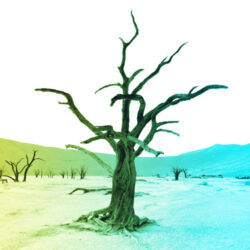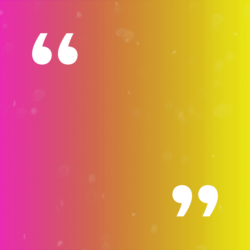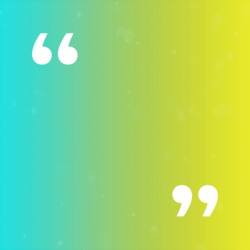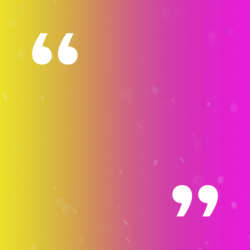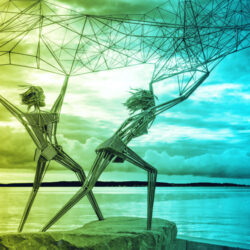
Introduction
In the face of a global ecological crisis, the devastating effects of climate change and the ongoing extinction of more and more endangered species due to human influence, the issue of climate justice has become an increasingly urgent matter. While some years ago manmade climate change for many was only a side topic, today it is subject to international politics, marketing and production forms of huge companies, wide international protests and individual lives including topics like living space, vacation planning or availability or choice of food products. The 1.5 degree target is still being discussed, while the worsening climate crisis is reflected in severe heat waves, droughts, water shortages, floods, plastics and burning oceans, species extinction and rising sea levels. A young generation cries out to save the future – of the planet and with it their personal future on earth. Climate change is one of the main drivers of the future, as “challenges arising from climate protection and sustainability goals will remain” (Prof. Dr. Jürgen Kropp).
The need to become active is growing. There are critics saying that individual actions in specific areas that promote sustainable action are no longer enough. There needs to be a fundamental shift in thinking, a cultural shift, if we are to live in balance with the planet and other inhabitants - if we want to stop climate change and continue to live on earth. What exactly does sustainability mean and what might such a cultural shift look like? What roles can artists and art institutions play in this change?
This text examines different aspects of sustainability and how artists and institutes of higher arts education (IHAE) can contribute to an understanding of sustainability while helping to initiate a cultural paradigm shift that will lead us to possible climate-just and sustainable futures.
Towards a Holistic Definition of Sustainability...

In the face of a global crisis, climate protection is increasingly moving into the focus of public perception.
But there are obviously many possible aspects when defining sustainability.

Scientists from all over the world are constantly discussing, researching and questioning the definition and scope of this term. In the article “Global Sustainability: Toward Definition” which was published already in 1987, Becky J. Brown and her team derived the following common themes connected to sustainability:
“The continued support of human life on earth
Long-term maintenance of the stock of biological resources and the productivity of agricultural systems
Stable human populations
Limited growth economies
An emphasis on small-scale and self-reliance
Continued quality in the environment and ecosystems
If one accepts an anthropocentric view of sustainability, with the focus being on indefinite and global sustainability, then there is a range of ways in which to construct a definition from the essential elements. In the narrowest sense, global sustainability means the indefinite survival of the human species across all regions of the world. A broader sense of the meaning specifies that virtually all humans, once born, live to adulthood and that their lives have quality beyond mere biological survival. Finally, the broadest sense of global sustainability includes the persistence of all components of the biosphere, even those with no apparent benefit to humanity.” (Brown et al, 1987)
34 years later and seemingly many steps closer to a global climate catastrophe...

The FAST45 stakeholders and other experts tend to define sustainability in a broader sense and a more holistic way:
"I am convinced that I can not say anything for sure about the distant future. But I believe that all the things we talked about, digitalization, climate, and the question of how we want to live as a society, will be relevant questions for the future. And, surely, this will not be resolved in two or five years. Things will be tough. It will be hard to shape a world we still want to live in." (Benjamin Benedict)
Benjamin Benedict is the Head of High End Drama and CEO of the production company UFA Fiction GmbH

Ecological sustainability and climate challenges seem to be deeply interconnected with economic and social cross-generational challenges like digitalization, (gender-)equality, social justice, accessibility, use of technology and information, power distribution etc. When talking about a broad understanding of sustainability, three main dimensions are recognized as "pillars" of sustainable development, these are the economic, environmental, and social aspects of sustainability. Assessing and evaluating sustainability is an important task in deciding what actions should be taken to make society more sustainable (Mehrbakhsh et al, 2019).
"For [our company] SAP, sustainability is not only about reducing the waste of energy. For us, sustainability also means creating a culture and a world that can be sustained in the future. This also includes topics like equality and providing the same opportunities for everyone." (Frank Feinbube)
Dr. Frank Feinbube, Head of Strategic Frontrunner Apps & Showcases, SAP Technology & Innovation. Feinbube was interviewed by the FAST45 Knowledge Alliance on the 12th of April 2021 together with his colleague Pit Humke, Expert Software Engineer at SAP Technology & Innovation.
“Right now two of the relevant discourses I see discussed in the film industry are diversity and sustainability. And that also has two components on the one hand ecological sustainability, like green producing issues and so on, but also social sustainability.” (Skadi Loist)
Skadi Loist is a professor for production cultures in audio-visual media industries at the Film University Babelsberg KONRAD WOLF, researching with a focus i.a. on film festivals, gender equity and labour conditions. Skadi Loist was interviewed by the FAST45 Knowledge Alliance on the 20th of May 2021

When we start to rethink how we interact with our environment, it becomes clear that sustainable futures do not stop with ecological concerns but have to be applied to human interactions, modes of working and moral values.
As Becky J. Brown noted in her article the Oxford English Dictionary defines sustainable as:
"'capable of being upheld; maintainable,' and to sustain as ‘to keep a person, community etc. from failing or giving way; to keep in being, to maintain at the proper level; to support life in; to support life, nature etc. with needs.’ The etymology of the terms originates in the French verb soutenir, ‘to hold up or support.’” (Brown et al, 1987)
Starting from this more literal definition, it is useful to first explain the different aspects of sustainability, which then can be combined into a more general definition.
Ecological Aspects of Sustainability

Ecological sustainability is a complex of many subterms and aspects. While it is necessary to observe, analyze and monitor already existing drivers and features of ecological or environmentally unsustainable practices, behaviours or trends one can also think of strategies to prevent the emergence of such or even to adapt to circumstances that are immutable.
Four Themes to Define Ecological Sustainability.

In her article “Developing organizational practices of ecological sustainability: A learning perspective” which was published in the Leadership & Organization Development Journal, Tara Fenwick (2007) identifies four themes to define ecological sustainability:
“[...] a sense of personal ethical responsibility for restoring healthier communities and eco-systems. The others are action: practices of renewal or involving minimal resources and waste in production and life activity; interconnectivity or acting with awareness of one’s relatedness to others in local, global and biological webs and the impact of one’s actions on them; and promoting local well-being, as nested within what Bohm (1980) calls the whole, implicate order” (ibid.).
These are derived by the method of synthesis from an older list of characteristics for organisational practices regarding ecological sustainability, stemming from Lange, E. (2001) in "Living Transformation: Beyond Midlife Crisis to Restoring Ethical Space" (unpublished doctoral dissertation, University of Alberta, Edmonton) which are also listed by T. Fenwick in her article:
“(1) using renewable energy by shifting energy sources from coal, oil and gas to solar power, direct or indirect, water and wind;
(2) eliminating waste from production involves taking greater responsibility for the whole life cycle of products as well as toxic effluent;
(3) restoring and conserving biodiversity understands that health of societies and ecosystems rests on rich variation (Hawken, 1993);
(4) adopting biomimicry using tools and technology to mimic natural processes: small scale, integrated in renewable cycles, and adaptable to the community level. [...]
(5) ensuring meaningful, fairly paid work in decent conditions;
(6) contributing to growth of holistic urban communities:
(7) contributing to reduce cities’ ecological footprint through integration of a diversity of activities and amenities in each neighborhood, (8) encouraging zero-emission industry;
(9) renewing neglected and unsafe areas (Todd & Todd, 1994); and
(10) incorporating restorative economy: building collective self-reliance and integrating commerce and technology into existing biological systems, focusing on the organization and local community’s internal resources and bioregion” (Fenwick, 2007).
In our interviews, respondents frequently emphasised...

... the environmental challenges facing our society and the adaptations and learning experiences that must be implemented in the everyday lives of individuals, groups, and larger social communities to respond to an ongoing climate crisis:
"Then another need is the living environment. So [there is a] reason why we at least once a year [go on] vacation and travel into the alps for skiing or to Italy, to Lake Garda, or elsewhere. The reason is, that we like the beauty of nature. Why not integrate the beauty of nature in the city?" (FAST45 Interview Partner)
"I've just seen an impressive film by a master of a Pacific island; he said, 'we are a small island—no one will help us in 50 years, our island will be gone. So what should I teach to the children? I should teach them building a canoe because no one will come and rescue us. So the only thing, the only valuable thing I can give to the next generation is the ability to build a boat and to travel. And so in my worst case scenario, it comes to that, there being nothing less than a few practical, but also creative skills. That will help us survive.'" (Antje Boetius)
Antje Boetius is a polar and marine researcher with a focus on deep-sea microbiology, ecology and how climate change impacts the oceans. She is the director of the Alfred Wegener Institute Helmholtz Centre for Polar and Marine Research (one of Europe's large oceanographic institutes). Antje Boetius was interviewed by the FAST45 Knowledge Alliance on the 25th of June 2021.
Social Aspects of Sustainability

Sustainability is often primarily thought of as ecological sustainability. But as already depicted, it has many dimensions. Many interview partners mentioned besides ecological sustainability also aspects of social sustainability that must be considered and that are entangled with the ecological and economical aspects of sustainability.
In general, it seems to be difficult to research and analyse social processes and developments qualitatively. Some problems that may occur when talking of “social sustainability” are, that processes in this field are hard to implement through planning and policy, structures are dynamic and hard to predict, enforcement or control in non-directional ways is difficult, models are not suitable for everyone in the world and success is difficult to identify and to measure in general.
So What Exactly is Sustainable in the Social Field?

The Office of the UK Deputy Prime Minister defined the term of sustainable communities in its publication “Sustainable Communities: Building for the Future” (2003) as follows:
“[Sustainable communities are] places where people want to live and work, now and in the future. They meet the diverse needs of existing and future residents, are sensitive to their environment, and contribute to a high quality of life. They are safe and inclusive, well planned, built and run, and offer equality of opportunity and good services for all” (ODPM, 2003).
Whereas other scientists relate to it as “the ability of society itself, or its manifestation as local community, to sustain and reproduce itself at an acceptable level of functioning in terms of social organization [ . . . ]” (Coleman, 1988).
In our interviews, social aspects of sustainability were addressed primarily through questions about the prevailing working practices and working conditions in the art world: Who works where and why? Whose art projects are supported? What stories are told through them and to what extent does what we do have an impact on desirable futures?
Economic Aspects of Sustainability

Another aspect of sustainability is the economical part, which describes an economy in terms of sustainable development that is functional in the long term. This involves building resilient infrastructure, promoting an inclusive and sustainable industry and fostering innovation that guarantees productive full employment and decent work for all (UN, 2015).
Circular economies that aim to reduce waste and reuse resources are a good example of which forms sustainable economies can take.
Weak Sustainability

While on the one hand the agenda of the United Nations focuses on inclusive and sustainable decisions within the context of economic activities and strives towards economic growth, on the other hand economic growth and its interconnectedness with the depletion of natural resources are fundamentally criticized (Paech 2013). Here, it is argued that it is precisely the vague definition of sustainability that we described above that “leaves it open to being misused by power groups who want to press their business-as-usual attitude into a new trendy setting” (Ott et al 2011, 14). Representatives of this view, referred to as "weak sustainability," argue that a substitution of natural resources by physical capital can in principle be substituted indefinitely as long as the average benefit to (some) humans is maintained over the long term (Döring et al 2001, 321). This anthropocentric view ignores the countless life worlds of non-human agents and reduces the manifold interdependencies on earth to a human-related cost-benefit calculation.
Strong Sustainability

Advocates of "strong sustainability" emphasise that natural capital can only be replaced by human or physical capital to a very limited extent, if at all (ibid.). In the course of this criticism, the triple bottom line framework of ecological, economic and social sustainability is also questioned, as it reduces the complexity of the sustainability debate to three apparent main factors, whose weighting among each other is partly arbitrary (ibid., 317).
Other approaches try to make the consideration more comprehensive by adopting the triple bottom line model or by entirely new models, but in many cases, the three-pillar model is still the basis of discourses.
A Cultural Change for a Sustainable Future

Evaluating the preceding insights, expert opinions and scientific findings, a more holistic view of the topic of sustainability opens up. It is about preserving and, in some aspects, reinventing a world in which people can live in freedom and protected by human rights, in harmony with nature, other species and in social coexistence for generations to come (UN, 2015). The role and power of technology must be constantly reassessed and re-evaluated in the ongoing digital revolution and upcoming human inventions. The sheer endless possibilities and dangers of a globally networked and algorithmically observed, evaluated, controlled planet need to be considered as much as the impact of new inventions on nature, our lives and our social communities, locally as well as globally. Knowledge, education and technology may give us the tools to prevent or mitigate natural and human-made disasters as well as the ability to break old patterns and ways of thinking that create social injustices.
But to achieve desirable futures of a sustainable world, a global cultural change is needed:
"We need to think about new narratives for modern societies. Because our current growth model is definitely not sustainable. And that ultimately means a cultural change!" (Prof. Dr. Jürgen Kropp)
Prof. Dr. Jürgen Kropp is the deputy chair of the Department of Climate Resilience at PIK (Potsdam Institute for Climate Impact Research), and head of the Urban Transformation Research group (PIK). He holds a professorship for Climate Change and Sustainable Development at the University of Potsdam. The interview was conducted by the FAST45 Knowledge Alliance on the 14th of April 2021.

This cultural shift describes the transition toward a society of sustainability and involves understanding the actions and processes necessary to achieve it. For this to happen, cultural narratives and habits must change, including our ways of thinking, our moral values and the way we interact within this world. Because it has become clear that the dominant discourses are "focusing too much on hardware updates, such as new technologies, economic incentives, policies and regulations, and too little on software revisions, that is cultural transformations" of minds (Kagan 2012, 10).
We must unlearn many of our deeply anchored beliefs and values and learn new ways of seeing, thinking and creating our world.
In this process art and creatives and with them the institutes of higher arts education can be the main driving force.
"The arts play an important role here, because the arts can express ideas and feelings or take them from scientific disciplines and make other wider groups in society aware of them. And that is a very, very important effect" (Prof. Dr. Jürgen Kropp).
Prof. Dr. Jürgen Kropp is the deputy chair of the Department of Climate Resilience at PIK (Potsdam Institute for Climate Impact Research), and head of the Urban Transformation Research group (PIK). He holds a professorship for Climate Change and Sustainable Development at the University of Potsdam. The interview was conducted by the FAST45 Knowledge Alliance on the 14th of April 2021.
Role of Art for a Cultural Change towards a Sustainable Future


FAST45 stakeholders see great potential in art to initiate, implement and drive this fundamental change in society. After all, art is generally regarded as capable of critical and unconventional thinking and of promoting change:
"Art has a transformative power." (Antje Boetius)
Antje Boetius is a polar and marine researcher with a focus on deep-sea microbiology, ecology and how climate change impacts the oceans. She is the director of the Alfred Wegener Institute Helmholtz Center for Polar and Marine Research (one of Europe's large oceanographic institutes). Antje Boetius was interviewed by the FAST45 Knowledge Alliance on the 25th of June 2021.
“Art detects dangers in social transformations before the rest of us see them.” (Clara Montero)
Clara Montero is the Cultural Director of Tabakalera, International Centre for Contemporary Culture
“We have already launched a residency program on environmental sustainability, which means that we will look at all our residency activities from a sustainability perspective. The main point and goal of the program is to find ways to generate new thinking in this area. How can we experience and live a reality where all these issues are already thought through and solved, where we are aware of the energy cycle and so on. And can the residency serve as a short term catalyst for change at this point?" (FAST45 Interview Partner)

Artists are special agents in this urgently needed cultural transformation process toward cultures of sustainability. Such a paradigm shift implies reforming our ways of knowing and acting upon our knowledge of reality. In this process, artists can act as mediators and translators, innovators and role models.
“[To build a sustainable future] the most important approach would be in the sense of forming utopian options. The challenge when shifting from the present structure that we live in towards a sustainable future is that everything seems to be in the way. And so if people have more options to think about, if people get options to play or to change roles and to try out how would it feel if I can no longer fly, or how would it feel, what would it mean if my voice would be heard? And I am a fish that wants to defend its future. So these ways of engaging, enhancing experience with often non-present problems is I think the strongest option [in how art can contribute to tackling complex societal and planetary challenges]." (Antje Boetius)
Antje Boetius is a polar and marine researcher with a focus on deep-sea microbiology, ecology and how climate change impacts the oceans. She is the director of the Alfred Wegener Institute Helmholtz Center for Polar and Marine Research (one of Europe's large oceanographic institutes). Antje Boetius was interviewed by the FAST45 Knowledge Alliance on the 25th of June 2021.
“[...] artists sort of translate it into having a bigger meaning for everybody.” (Anna Eschenbacher)
Anna Eschenbacher is currently studying the master's program Creative Technologies at Film University Babelsberg KONRAD WOLF in Germany. She was interviewed by the FAST45 Knowledge Alliance on the 15th of March 2021.

But how exactly can artists initiate and reach a cultural change towards sustainable futures?
Our respondents answered with multiple ways art practices can contribute to a cultural change towards sustainability.
On the one hand, artistic practice can raise awareness of climate justice by making them directly the subject of art or by communicating them in new, creative, playful and experimental manners. An artwork can reach and touch people emotionally, foster empathy, or rationally argue and translate scientific knowledge.
On the other hand, art is sometimes able to communicate in a way that eludes words and addresses us in a non-cognitive way. This way artists can use their work to develop models for sustainable environments and futures, and open up and communicate new perspectives. They can make people experience what it means to live in a sustainable or unsustainable world and show possible consequences in the form of potentially (in)satisfying situations.
In today's societies, artists and creative people often serve as role models, which they can use by addressing these important issues and setting an example through sustainable ways of thinking and acting. Here, in addition to their production methods and the use of sustainable materials, the structural form of their working methods, their solidarity and their general interaction can also serve as role models for aspects of social sustainability.
Making the Art Practice more Sustainable


When talking about holistic sustainability in the arts, it is feasible to discuss what might be called "applied sustainability” in art practices. That means also questioning how sustainable art and creative works are produced, exhibited, distributed, reused or marketed in the different creative fields and also in different countries around the globe. Due to the complexity and versatility of an international art and creative scene, it does only expedient to a limited extent to search for general rules or laws in this subject area. It seems rather necessary to create an understanding of holistic sustainability among the artists themselves, to offer them approaches or ideas on how to solve existing problems at an early stage and to find alternatives to evidently unsustainable practices in arts. As they are a crucial part of the art world, it is also necessary to involve exhibition venues, stages, agents, managers, buyers, distributors and the audience of art themselves in this thinking process. During one of the expert interviews, the educator and activist Airi Triisberg points out the entanglement of art practices with cultural trends - such as a seemingly existing pressure for artists to constantly produce works of art quickly and anew as well as an expectancy that art should be showcased around the globe:
“The current art world as we know it is very much based on circulation and mobility. And then also production, because you constantly need to produce something new. It's always very much valued, when the artist made a new work and every exhibition needs to be made new. A more grim perspective, from a climate perspective. I think a lot of art institutions and our usual ways of consuming, exhibiting and producing art should not exist in this way.” (Airi Triisberg)
Airi Triisberg is a freelance art worker, educator and activist currently based in Tallinn and was interviewed by the FAST45 Knowledge Alliance on the 30th of April 2021.
How Can Institutes of Higher Arts Education Enhance a Cultural Change towards a Sustainable World?


The arts educational institution itself can play an exemplary role in the change that needs to happen.
On a structural level, there are many ways to make Institutes of Higher Arts Education, as centres of art and culture in their respective cities, more sustainable places. Many universities have already started to design their outer shell in terms of green architecture “that advocates for building with the environment in mind by using sustainable sources of energy, designing efficiently to reduce energy use, and updating existing buildings with new technology” (Nicholas Van Antwerp, 2022).

Like a sustainable architecture the internal processes and offers can also be made more sustainable and, in this sense, more effective in a future effort against unsustainable practices.
Green Processing describes a logistical principle that can be implemented as far as possible in everyday work, the materials used, the food offered, the communication channels, an integration into the city's life and a connection to sustainable means of transport.
Topics such as the recycling/upcycling and economical use of materials and resources, the selection of more sustainable working materials and the critical questioning of sometimes outdated processes and methods can be introduced into everyday university life.
Institutes of Higher Arts Education can raise the profile of sustainable modes of education by adapting their methods of learning, doing, and teaching. In our interviews, the areas of virtual learning and the implementation of sustainability awareness as well as the teaching of sustainability-oriented project planning in the curriculum of the universities were named as relevant topics. It is the task of art universities to present, discuss and apply sustainable materials and tools to the creative and artistic minds of tomorrow, rethink processes of creation in climate-just ways and support innovative thinking towards sustainable solutions on all levels. This also means fostering, teaching, and enhancing critical thinking, empathy, decolonial thinking, transcultural thinking and transdisciplinary thinking.
"I think this is the main issue to use these years, these precious years [of studying], to understand that there's a life outside these walls" (Alexander Hollensteiner)
Alexander Hollensteiner is the general manager of the Kammerakademie Potsdam (Germany). The interview was conducted by the FAST45 Knowledge Alliance on the 12th of Mai 2021.
"[...] Our future is going to be transdisciplinary, no doubt. And the solutions that we all need, we all expect. And if we hope to survive, we expect certain solutions to come from a multidisciplinary, transdisciplinary layer. Nobody's expecting that one single professor would save the world. So we need all of them working together. Then this is one of the most important developments in our educational system that we have to address. And it is to enable, to empower each and every student, not only the students of art, to empower them, to be able to talk across the borders of their own discipline and address the challenges they might find in their own discipline - also in a way that others, the so-called untrained audience, could participate in that discussion." (Horst Hörtner)
Horst Hörtner is the director of the ars electronica Futurelab, a department within the context of the ars electronica in Linz (Austria). He was interviewed by the FAST45 Knowledge Alliance on the 11th of May 2021

In all these endeavours, it is important to take holistic and inclusive approaches and act at the institutional, national, and international levels and involve Institutes of higher arts education's administrations, teachers, students, urban planners, architects, politicians, and other stakeholders and derive implementable principles for art universities of the future through cross-linked problem thinking.
The change towards sustainable cultural practices is urgently needed and in order to anchor new behaviours and awarenesses and unlearn old destructive thinking and habits, art institutes, artists, creatives and cultural practitioners need to realise their power and responsibility in this process.

Accordingly, the challenge also lies in the transition between the boundaries of disciplines and practices. Therefore, it is important to evaluate the sustainable aspects in art education practice, such as the interaction between courses of study, but also the transition from academic training to active professionalism and the established processes and standards regarding the handling and presentation of art.

For a practical approach to what Institutes of Higher Arts Education can and should do now to enhance a change towards sustainable futures take a look at the claims for climate-just art schools of Klasse Klima, a student-led organisation for climate justice at the Berlin University of the Arts (UdK) in 2020: https://klasseklima.org/projec.... Klasse Klima like other initiatives, unambiguously calls for more climate-just action of art educational institutions.
The work of Klasse Klima is an inspiring example of younger generations of artists taking action to live a climate-just and sustainable future.
Climate-just thinking, education and action can no longer be an option!

The urgency to save our future grows stronger every day.
For art universities, this means that they must quickly restructure. Climate awareness must raise on all levels of the institution. Climate justice and sustainability must become first priority in decision-making. Sustainable ways of working must be integrated on the social and ecological levels. Institutes of higher arts education need training in all areas of work on the subject of sustainability for all staff. These can range from workshops on climate-friendly ways of working, equity, multi-species learning, food education and canteen restructuring to sustainable future scenario-building labs.
Besides restructuring on the ecological level, we need a shift in thinking in human resources and work culture: a cultural shift towards sustainability means that success and prosperity (of the few) can no longer be based on short-termism and exploitation (of fossil and human resources). Who gets hired? How do create fair labour relations long-term? Who do we collaborate with? How do we make decisions? Sustainable thinking concerns all these areas.
Sustainable and climate-just thinking must be integrated into all courses and projects. Alternatives must be taught. What materials do we use? What ways of travelling do we choose? How many working hours do we plan? And how much processing power is needed to sustain the project in the long run?
Making sustainable thinking part of everything that is happening in art academies and finding climate-just and fair solutions should happen in playful ways. We must be aware that we as humans are all together in the process of finding ways to sustainable futures. Pretending that we have answers to all questions would be another form of green-washing. Therefore inviting students to curiously question art practices, materials and ways of working will prove better than nourishing shame and fake solutions with competitive behaviour and inflictive evaluation. Every project will potentially bring up challenges when it comes to sustainability. And the creative potential of curiosity can lead to innovative solutions. These challenges should be discussed in transdisciplinary workshops as more holistic views usually generate new impulses and inspiration. Possible starting points should be followed up not only by students but on an institutional level. Art universities need to foster artistic research and material research for sustainable futures with students and in larger research projects.
Thanks to this supportive, curious and playful learning culture where a fruitful exchange is part of every day, and everyone is pursuing the same goal of finding sustainable ways of doing art, future artists will hopefully internalise, further develop and embody sustainable ways of thinking and acting and integrate them in their work outside of the institution. Art institutions can thus become germ cells from where the cultural shift toward sustainable futures will spread.
References
Brown, Becky J., Mark E. Hanson, Diana M. Liverman, and Robert W. Merideth. 1987. “Global Sustainability: Toward Definition.” Environmental Management 11 (6): 713–19. https://doi.org/10.1007/BF0186....
Coleman, James S. 1988. “Social Capital in the Creation of Human Capital.” American Journal of Sociology 94: 95–120. https://www.jstor.org/stable/2....
Döring, R., and K. Ott. 2001. “Nachhaltigkeitskonzepte.” In Zeitschrift Für Wirtschafts- Und Unternehmensethik, 315–42. Baden-Baden, Germany. https://www.ssoar.info/ssoar/h....
Fenwick, Tara. 2007. “Developing Organizational Practices of Ecological Sustainability: A Learning Perspective.” Leadership & Organization Development Journal 28 (7): 632–45. https://doi.org/10.1108/014377....
Kagan, Sacha. 2012. Toward Global (Environ)Mental Change: Transformative Art and Cultures of Sustainability. Publication Series on Ecology 20. Berlin: Heinrich-Böll-Stiftung.
Klasse Klima. 2020. “Detaillierte klimapolitische Forderungen der Klasse Klima.” n.p. https://klasseklima.org/projec....
Nilashi, Mehrbakhsh, Parveen Fatemeh Rupani, Mohammad Mobin Rupani,
Hesam Kamyab, Weilan Shao, Hossein Ahmadi, Tarik A. Rashid, and Nahla
Aljojo. 2019. “Measuring Sustainability through Ecological
Sustainability and Human Sustainability: A Machine Learning Approach.” Journal of Cleaner Production 240: 118162. https://doi.org/10.1016/j.jcle....
Office of the Deputy Prime Minister (ODPM). 2003. “Sustainable
Communities: Building for the Future.” https://webarchive.nationalarc....
Ott, Konrad, Barbara Muraca, and Christian Baatz. 2011. “Strong
Sustainability as a Frame for Sustainability Communication.” In Sustainability Communication,
edited by Jasmin Godemann and Gerd Michelsen, 13–25. Dordrecht:
Springer Netherlands. https://doi.org/10.1007/978-94....
Paech, Niko. 2013. “Economic Growth and Sustainable Development.” In Factor X,
edited by Michael Angrick, Andreas Burger, and Harry Lehmann, 30:31–44.
Dordrecht: Springer Netherlands.
https://doi.org/10.1007/978-94....
United Nations. 2015. “Transforming Our World: The 2030 Agenda for
Sustainable Development.”
https://sdgs.un.org/sites/defa....
Van Antwerp, Nicholas. n.d. “What Is Green Architecture? How It
Informs Modern Sustainability.” Accessed March 20, 2022.
https://learn.g2.com/green-arc....
Table of figures in the order of appearance
1) Photo by Connor McSheffrey on Unsplash
2) Photo by Franz Hajak on Unsplash
3) Photo by Peter Burdon on Unsplash
4) Photo by Markus Spiske on Unsplash
5) Photo by Tim Marshall on Unsplash
6) Photo by Christian Wiediger on Unsplash
7) Photo by Javier Allegue on Unsplash
8) Photo by Mmariya Tereshkova on Unsplash
9) Photo by Jakob Owens on Unsplash
10) Photo by Darya Jum on Unsplash


